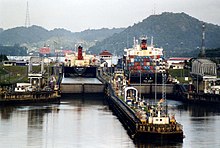Panamax

Ships classified as Panamax are of the maximum dimensions that will fit through the locks of the Panama Canal. This size is determined by the dimensions of the lock chambers, and the depth of the water in the canal. Panamax is a significant factor in the design of cargo ships, with many ships being built to exactly the maximum allowable size.
Dimensions
Panamax is determined principally by the dimensions of the canal's lock chambers, each of which is 33.53 metres (110 ft) wide by 320.0 metres (1050 ft) long, and 25.9 metres (85 ft) deep. The usable length of each lock chamber is 304.8 metres (1000 ft). The available water depth in the lock chambers varies, but the least depth is at the south sill of the Pedro Miguel locks, and is 12.55 metres (41.2 ft) at a Miraflores Lake level of 16.61 metres (54 feet 6 in). The height of the Bridge of the Americas at Balboa is the limiting factor on a vessel's overall height.

The maximum dimensions allowed for a ship transiting the canal are: [1]
- Length: 294.1 metres (965 ft)
- Beam (width): 32.3 metres (106 ft)
- Draft: 12.0 metres (39.5 ft) in tropical fresh water (the salinity and temperature of water affect its density, and hence how deeply a ship will sit in the water)
- Height: 57.91 metres (190 ft) measured from the waterline to the vessel's highest point
A Panamax cargo ship would typically have a displacement of around 65,000 tons.[2]
Exceptions
Vessels up to 62.5 metres (205 ft) in height may pass by prior approval, co-ordinated with low tide at the Bridge of the Americas.
On an exceptional basis, vessels up to 32.61 metres (107 ft) in beam may be permitted to transit, subject to additional draft constraints.
Vessels with structures extending beyond the maximum length and/or beam above the level of the lock walls may be permitted transit subject to inspection and approval.
During an exceptionally dry season, when the water level in Lake Gatún is low, the maximum permitted draft may be reduced.
The longest ship ever to transit was the San Juan Prospector, now Marcona Prospector, an ore-bulk-oil carrier that is 296.57 metres (973 ft) long, with a beam of 32.3 metres (106 ft).[3] The widest ships to transit are the two North Carolina class battleships, USS North Carolina (BB-55) and USS Washington (BB-56), which have beams of 33.025 metres (108 ft 3.875 inches).[4]
Impact on shipping

Panamax continues to be a noteworthy factor in ship design, with an increasing number of ships being built precisely to the Panamax limit, in order to transport the maximum amount of cargo in a single vessel.
The increasing prevalence of vessels of the maximum size is a problem for the canal. A Panamax ship is a tight fit that requires precise control of the vessel in the locks, possibly resulting in longer lock time, and requiring that these ships be transited in daylight. Since the largest ships cannot pass safely within the Gaillard Cut, the canal effectively operates an alternating one-way system for these ships.
Many modern ships, known as post-Panamax ships, are far larger than this (and hence cannot use the canal). This is the case for supertankers and the largest modern container ships; much bulk merchandise such as grain products is moved primarily on Panamax (or sub-Panamax) ships. U.S. Navy supercarriers are also in the post-Panamax class; the Nimitz class aircraft carriers are 333 metres (1092 ft) long overall with a beam of 41 metres (134 ft), while the flight deck is 76.8 metres (252 ft) wide.
Expansion


As early as the 1930s, new locks were proposed for the Panama Canal to ease congestion and to allow larger ships to pass. Plans for expansion of the canal are once more under consideration but remain speculative, hampered by considerations of cost and water supply (see Panama Canal).
Post-Panamax
Post-Panamax is the term for ships larger than Panamax, which do not fit in the original canal. The term for the second set of enlarged locks is yet to be determined.
After expansion, the Panama Canal is expected to be able to handle vessels upto 12000 TEU in size; currently, it can only handle vessels upto 5000 TEUs. It is estimated that this expansion will be completed by 2014. A third lock, 14,000 feet long, 180 feet wide, with a draft of 50 feet will supplement the two existing locks.
See also
References
- ^ Vessel Requirements, from the Panama Canal Authority
- ^ Modern ship size definitions, from Lloyd's register
- ^ Background of the Panama Canal, Montclair State University
- ^ Battleships, United States Battleships in World War II, by Robert O. Dulin, Jr. and William H. Garzke, Jr.; pages 62 and 145. Naval Institute Press, 1976. ISBN 0-87021-099-8
